
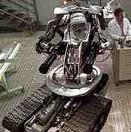
South Korea just unveiled the first generation of autonomous robots armed with lethal weapons. They’ll eventually be deployed to help secure their 155-mile-long border with North Korea, and they come equipped with rubber bullets and machine guns. According to the Associated Press:
The robot also can distinguish people from moving objects such as a vehicles from up to 1.2 miles away in the daytime, and half that distance at night, the ministry said in a news release.
It can identify an enemy up to 30 feet away through a password, the news release said.
It also probably thinks humans taste like “bacon”.
(Thanks to Robot World Online for this one!)
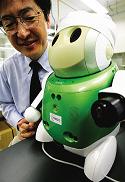
So, apparently the guys at NEC thought it would be cool to make a wine-tasting robot. The robot — pictured above — fires a beam of light into the wine, and then uses an infrared spectrometer to analyze the reflection. It studies the chemical composition of the wine and delivers an instant verdict about how good it is. It’s a neat trick, and it has other health-related skills: It can determine whether an apple is sweet or sour, or could even warn its owner if a food is too salty or fatty.
But the NEC guys decided to show off the robot to the media, and that’s when it revealed its morbid secret. As the Associated Press reports:
When a reporter’s hand was placed against the robot’s taste sensor, it was identified as prosciutto. A cameraman was mistaken for bacon.
Yeah, we’re screwed. The robots think we taste like crispy breakfast treats.
(Thanks to Robots.net for this one!)

Sterling J. Nesbitt, a graduate student in paleontology, recently took the Manhattan subway to the stop that lies beneath the American Museum of Natural History. While waiting on the platform, he checked out a way-cool bronze cast, displayed on the wall, of a Coelophysis bauri, a predatory dinosaur. Pictured above, the cast is wonderfully detailed, and even shows the contents of the dinosaur’s last meal. Paleontologists have long assumed that meal was cannibalistic: The Coelophysis had eaten one of its own.
But when Nesbitt looked at it, he realized they were wrong. The femur lodged in the dinosaur’s stomach was that of a small crocodile.
Duly inspired, Nesbitt worked up a paper reporting his findings, which was published last week in Biology Letters of the Royal Society of London. And apparently he’s now upended the cannibalism consensus regarding Coelophysis. As he told the New York Times:
“Our research shows that the evidence for cannibalism in Coelophysis is nonexistent,” Mr. Nesbitt said in an interview, “and the evidence for cannibalism in other dinosaurs is quite thin.”
I love it. Pioneering paleontological research, conducted in the New York subway system! Now somebody should look into CHUDs.

Doing psychological research on celebrities isn’t easy. They’re surrounded by phalanxes of PRbots whose job is to protect them, with Dalek-like effiency, from any unscripted contact with the outside world.
One of the few people who enjoys (if that’s the word) regular contact with celebs is Drew Pinsky, cohost of the show Loveline. Since celebrities frequently appear as guests on the show, Pinsky — who is actually a physician and, in theory, a researcher — realized he had a golden opportunity to collect data on them. So he decided to measure their narcissism levels, by asking them to fill out the Narcissism Personality Inventory, the defining test of this personality trait. The NPI asks people to make a forced choice between pairs of statements like “I can read people like a book” or “People are sometimes hard to understand.” The result is a score out of 40, with higher scores meaning “more narcissistic”. Over a 20-month period, Pinsky got 200 actors, comedians, musicians and reality-TV stars to complete the survey.
The results? Celebrities averaged a score of 17.8 out of 40. That’s 16% higher than the score of the average American, which is 15.3. Interestingly, though women in the general population measure as less narcissistic than men, female celebrities were more narcissistic than male ones, 19.26 versus 17.27.
Perhaps more interestingly, the more work and discipline your particular brand of famousness requires, the less narcissistic you tend to be. Musicians — who have to actually possess, nuture and deploy a technical skill — were the least narcissistic of all celebrities. In contrast, reality-TV stars, who possess — almost by definition — no skill at anything, were the most narcissistic. “Female reality show contestants,” Pinsky told the LA Times, “are off the chart.”
Another narcissism researcher, the University of Georgia’s Keith Campbell, has apparently been finding that college students are getting more narcissistic too. He argues that reality TV is one of the big cultural drivers:
“By definition, it’s supposed to be reality, and you have a sample of people who are more self-absorbed, more entitled, more vain than the normal population, that is going to pull the population in the direction of narcissism. If the self-absorption you see on ‘Laguna Beach’ or ‘The Real World’ is viewed as normal, the culture will be pushed in that direction. Our levels of self-esteem and narcissism are already pretty high. I don’t know if we need more of it.”
I dunno — I think the college-aged audience for reality TV is a wee bit more sophisticated that that, and probably understands that the people you see on reality-TV shows are more hysterically conceited than everyday folk. But Campbell is certainly also right that endless exposure to TV shows where the goal is merely to become famous for “keepin’ it real” — by which I mean, “being a sociopathically self-absorbed asshole” — is bound to corrode one’s soul. Is this really the stuff we ought to be feeding impressionable youth? Why there oughta be a law.
I’m kidding, sort of, but this stuff tends to express my latent David Brooks gene. I genuinely worry that pop culture has so thoroughly oriented itself around the romantic equation of self-expression=good that the idea of being skillful and disciplined at anything is falling by the wayside. Then again, I’m a puritan work-ethic freak — and a musician, heh — who far prefers to talk to scientists than celebrities, so I would think that.
I’m coming late to this one; everybody blogged about this a month ago. But I’m looking forward to reading Pinksy’s paper on this when it comes out!
(Thanks to Arts and Letters Daily for this one!)

Economists have long noticed that people who drink tend to make more money than those who don’t. Now a new study offers a theory to explain this: People who drink are more socially gregarious than nondrinkers, which increases the size of their Rolodexes and, by extension, their earning potential.
Or to put it another way: Drinking is the original social-networking technology.
In their paper — “No Booze? You May Lose: Why Drinkers Earn More Money Than Nondrinkers” — Bethany Peters and Edward Stringham used General Social Survey data to classify respondents into non-drinking, drinking, and “social drinking” categories. When the economists examined the respondents’ earnings, they found that drinkers made about 10 to 14 per cent more than abstainers. Even more suggestively, “social” drinkers — the ones out in bars — made an additional 7 per cent on top of the normal drinking premium. As Stringham told the AFP, “social drinkers are out networking, building relationships, and adding contacts to their BlackBerries that result in bigger paychecks.”
In contrast, abstainers have smaller social networks. This, the authors suggest, may be because …
… abstainers may prefer to interact with other abstainers or less social people. Alternately, abstainers might not be invited to social gatherings, work-related or otherwise, because drinkers consider abstainers dull.
Heh. If the prose were any drier this study would spontaneously combust. Given that this work was done for the libertarian Reason Foundation, it’s probably not surprising that the authors regard antidrinking advocacy as total buzzkill. And I have to admit, as a devoted fan of both high-end single-malt scotch and egregiously cheap beer, I kind of enjoyed all the cheap shots leveled at teetotallers. I also chuckled at how Peters and Stringham described the way they developed their hypothesis: A combination of “casual observation and scholarly accounts”, which sounds like code for “getting smashed at Trader Vic’s.”
And check out the wacky graphics they included in the paper! I’ve excerpted some above. It’s all this clip-art of people drinking themselves legless. If I weren’t convinced the study is legit I’d suspect those pictures were the covert signal that this is a media prank.
(Thanks to Plastic for this one!)

This made me chuckle. Randall Monroe is a NASA roboticist who produces the incredibly funny xdcd online comic strip, which specializes in super-nerdy math humor. He also recently created the t-shirt pictured above: The first panel is on the front, and the second panel is on the back. As he describes it on his web site:
Science: We finally figured out that you could separate fact from superstition by a completely radical method: observation. You can try things, measure them, and see how they work! Bitches.
The graph on the back of the shirt is data from the COBE mission, which looked at the background microwave glow of the universe and found that it fit perfectly with the idea that the universe used to be really hot everywhere. This strongly reinforced the Big Bang theory and was one of the most dramatic examples of an experiment agreeing with a theory in history — the data points fit perfectly, with error bars too small to draw on the graph. It’s one of the most triumphant scientific results in history.
(Thanks to Kevin Cornwall for this one!)
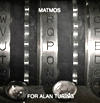
I love it: The experimental-music duo Matmos recently got their hands on a real-life Engima machine, recorded its typewriter-like clicking, and used it in a piece of music they’re about to release.
The Engima machine is, of course, the cryptographic system famously used by the Nazis, and equally as famously broken due to the work of mathematician genius Alan Turing. When I visited the U.K. three years ago I visited Bletchley Park — Britain’s WWII code-breaking headquarters — and got a chance to actually use an Engima machine with my own hands, which was, of course, awesomely fun. So I can attest that it makes some kinetically nifty clickety-click noises.
How precisely did Matmos get to record one? As they report in a Q&A in Seed magazine:
How did you get your hands on an Enigma machine?
Drew Daniel: Robert Osserman [of the Mathematical Sciences Research Institute] is the husband of my dissertation director. He put us in touch with this corporation called Cryptography Research. That place was insane. They had retinal scanners on the walls to go into certain rooms. It’s a serious cryptography Valhalla.
And you recorded from the Enigma?
Daniel: Yeah … There’s this mantra, “every noise has a note.” It’s basically true. Even the Enigma machine is in a particular key.
I’d love to hear the piece, but unfortunately the only available online clip currently seems to be unavailable. As I type this, though, I’m currently listening to some Matmos on Rhapsody (“Rag for William S. Burroughs”) and I have to say — even though I’m not much of a fan of experimental, real-world-sample-heavy music, it’s awfully good stuff! They really seem to listen carefully to their samples and arrange them in musically artful ways; yet it’s still oddly synchopated enough that when the nearby microwave in my office’s kitchen just went “beep”, I momentarily thought the noise was inside the song. I hope they release their new Turing song onto Rhapsody soon.
By the way, Matmos is apparently the name of the living liquid under the city of Sogo in the film Barbarella. Man alive these guys are nerds.
(Thanks to Sci Tech Daily for this one!)

Heh — this is easily the most misleading headline I’ve written in years! But it’s not actually inaccurate.
Reason recently published an excellent interview with Wired editor-in-chief Chris Anderson, to talk about his superb book The Long Tail — an investigation of how niche markets are becoming bigger business than hits. At the end of the interview, Anderson talks about a band he played bass for in the 1980s that was called …. R.E.M.
It’s not that R.E.M., of course. But both bands did briefly exist at the same time, and Anderson had a fascinating interaction with the, uh, “real” R.E.M. When Anderson’s band was preparing to release its album, their concert promoter decided it would be fun to have both bands fight it out for the final rights to be be called R.E.M. So they had a battle of the bands at the 9:30 club in Washington, DC. As Anderson tells it:
reason: Obviously you did not win the battle of the bands, did you?
Anderson: I would say we lost resoundingly.
I think the first song they played was “Radio Free Europe.” It was clear from the first chord what the outcome of that decision was going to be.
reason: And the winner got to rename the loser, right?
Anderson: In the aftermath of this resounding defeat and with a lot of fear involved, we emerged named Egoslavia.
Nice. Appropriately enough, Anderson points out that by turbo-charging niche markets and allowing niche fans to cluster online, the Internet has actually created a resurgence of minor 80s bands — including his. There are people who’ve actually sampled Egoslavia/R.E.M. tracks.

Wired News has just published my latest video-game column, and this one is about the problem of the supposed “40 hours of gameplay”. By which I mean, many of today’s adventure games promise 40 hours of gameplay. But the hard-core players find this is false because the game goes by too quickly — the rest of us find it’s false because we face the opposite problem: The game takes so long to play we never finish it.
It’s online for free here, and an archived copy is below!
The Myth of the 40-Hour Gamer
by Clive ThompsonI call it “the myth of the 40-hour gamer.” Whenever you pick up a narrative adventure game these days, it always comes with this guarantee: This game offers about 40 hours of play.
This is precisely what I was told by Eidos — and countless game reviewers — when I picked up Tomb Raider: Legend earlier this year. As I gushed at the time, Legend was the first genuinely superb Lara Croft game in years, with a reinvigorated control system, elegant puzzles, and an epic storyline involving one of Lara’s long-vanished colleagues. I was hooked — and eager to finish the game and solve the mystery. So I shoved it into my PS2, dual-wielded the pistols and began playing …
… until about four weeks later, when I finally threw in the towel. Why? Because I couldn’t get anywhere near the end. I plugged away at the game whenever I could squeeze an hour away from my day job and my family. All told, I spent far more than 40 hours — but still only got two-thirds through.

Here’s a neat bit of mind-hack research: A couple of psychologists have found that multitasking is easier to do if the various streams streams of info you’re trying to monitor arrive in different modes.
Which is to say, it’s relatively easy to drive a car and listen to music because they’re different stimuli: One is primarily visual, while the other is auditory. In contrast, trying to conduct two conversations at once is hard because they’re both vocal information. As one of the researchers puts it:
Humans learn “sequential structure from multiple sources at the same time, as long as the sensory characteristics of the sources do not overlap,” Christiansen said.
This is only the press release — study won’t be published until next month — so I don’t know more about their experiment or their findings. But as I wrote in my life-hacking piece of last year, this is a problem the computer industry has been grappling with for years. People are running more and more applications simultaneously on their computers — chat, word processing, web surfing, email — and there’s only so much screen space. Since each of these programs relies mostly on visual stimuli, they all wind up overlapping and confusing the heck out of us.
Now, as reseachers like Mary Czerwinski have found, getting a larger screen can improve your productivity by up to 10% merely because it lets you juggle more visual inputs at once. But clearly there’s still an upper limit to our attention. So maybe the answer lies, as the folks in the ambient-technology community would argue, in moving some of our computing tasks away from the screen? If more computing information came to us via audio, we could monitor more streams at once without having the data collide with one another.
Of course, we could also just stop the madness and turn some of those streams off, heh. But where’s the fun in that?
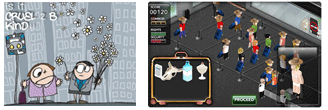
Ian Bogost, one of my favorite game designers, has hit a double this week — he has two nifty titles launching.
The first one, co-designed along with Jane McGonigal, is Cruel 2 B Kind. It’s a real-world game that is a dementedly smart reskinning of Assassin. Like Assassin, you’re tasked with hunting down someone and “killing” them in public. Except in this case, a) you don’t know precisely who your target is, and b) the “weapon” you’re issued is an act of kindness — such as offering someone a compliment.
The players are turned loose in a public area that is filled with tons of random strangers who, of course, aren’t playing the game and are unaware any game is going on. You have to just go up to strangers, perform your act of kindness, and see whether it kills them. The only way to figure out who the other combatants are is to be on the lookout for other people performing similarly random acts of kindness. As the rules note:
Your secret weapon is the act of kindness you perform on suspected targets. Example: Praise your targets’ shoes. If you perform this weapon on the correct target, they will surrender. If you perform this weapon on other players who are not your target, they will say “You are too kind.” If you perform this weapon on non-targets … well, we have no idea what might happen!
Thus, tomorrow we’ll witness the delicious spectacle of befuddled New Yorkers wondering why in god’s name they’re being accosted by so many friendly strangers. I love it. However, the game is part of the Come Out And Play festival, which tragically was scheduled to coincide with Rosh Hashanah, so I’m going to be out of town and miss it. Waah! Somebody attend and tell me what it was like!
Ian’s other game is Airport Security, an online Flash game that parodies the recent ban on in-flight liquids. You play as an airport screener, and your job is to divest people of sundry and hilarious personal items — cell phones, snakes, their pants, goldfish bowls — while ensuring the line moves along swiftly. Basically, it’s a serious-game iteration of the Bruce Schneider critique of airport security, which is that “airport security is the last line of defense, and not a very good one at that”. Even those who disagree with the thesis of the game would probably still find it a hoot to play, though — it’s that witty.
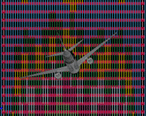
By now, you’ve probably read about the many 9/11 conspiracy theories. A lot of them argue that the World Trade Center buildings were intentionally demolished by controlled explosions. That’s because, as the conspiracy theorists argue, a jetliner collision would not be sufficient on its own to destroy the buildings. Now, the whole reason this theory has gotten any legs at all is that it’s impossible to test it in the physical world; no-one’s going to fly a plane into a massive skyscraper just to prove or disprove whether it would destroy it.
But now a team of computer scientists at Purdue going to settle the matter — by running a virtual simulation of the planes hitting the WTC buildings. So far, they’ve spent 80 hours using a 16-processor computer to simulate the first half-second of impact. (That’s a still from it above.) The early results are intriguing, and — as you might expect — debunk the conspiracy theories. As a story on the Purdue site notes:
“Current findings from the simulation have identified the destruction of 11 columns on the 94th floor, 10 columns on the 95th floor and nine columns on the 96th floor,” he said. “This is a major insight. When you lose close to 25 percent of your columns at a given level, the building is significantly weakened and vulnerable to collapse.”
By the way, I should point out that the Purdue research wasn’t initiated specifically in response to the conspiracy theories; they’re doing it both just as pure research and to get a better understanding of engineering frailties. But it’s still a pretty interesting way to help put some of these rumors to rest.
Indeed, this is one of the principles behind many “serious games”: That simulations can be terrific ways to test out theories. Right after 9/11, I remember hearing that a lot of pilots cracked open their copies of Microsoft Flight Simulator, dialled up the 747, and tried to see if they could crash it into the buildings. It wasn’t disrespectful or gratuitous. They were as traumatized as anyone else — maybe even more so, given their profession — and this was a way of emotionally coping; they wanted to see if it were really that easy to hit the buildings.
I’m also reminded of JFK Reloaded, the game that put you in Lee Harvey Oswald’s shoes and tried to see if you could perfectly replicate the way JFK was killed. The concept behind the game was actually quite smart: If there’s a conspiracy theory arguing that a lone gunman couldn’t have pulled off the assasination, then why not create a sim and let people see if it were possible? In the game, you could also place yourself on the grassy knoll and see for yourself how it changed the head-wound ballistics.
The problem with JFK Reloaded was while the concept was interesting, the designer went rather overboard; there was arguably no need to so precisely emulate the flying pieces of bodily flesh, as the game did. (And there’s something inherently creepy about shooting not at fictional, anonymous, imaginary enemies, but at real-life folks, including one whom is still alive. I wrote a piece for Slate making this point, but it was unfortunately rather incoherent — I was on a tight deadline — and I don’t think I adequately argued that the concept of a historical sim is not necessarily a bad thing.)
Anyway, I’ll be intrigued to hear the full results of this Purdue simulation!
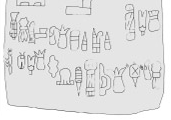
I love unsolved ancient texts. So I was delighted read that archaelogists have discovered a 3,000-year-old piece of chiselled rock that contains the oldest writing found in the Western Hemisphere. Nobody can yet figure out what it says, but it looks like it was generated by the Olmec, a pre-Mayan society in the Gulf of Mexico mostly known for carving gorgeous and weird stone heads. (No-one is quite sure what the heads represent, but since the Olmec were known for playing a game that used a rubber ball — Olmec literally means “rubber people” — it’s hypothesized that the statues might be renditions of famous rubber-ball athletes.)
As the New York Times reports:
The tiny, delicate signs are incised on a block of soft serpentine stone 14 inches long, 8 inches wide and 5 inches thick. The inscription is on the stone’s concave top surface.
Dr. Houston, who was a leader in the decipherment of Maya writing, examined the stone with an eye to clues that this was true writing and not just iconography unrelated to a language. He said in an interview that he had detected regular patterns and order suggesting “a text segmented into what almost look like sentences, with clear beginnings and clear endings.”
Some pictographic signs were frequently repeated, Dr. Houston said, particularly ones that looked like an insect or a lizard. He suspected that these were signs alerting the reader to the use of words that sound alike but have different meanings — as in the difference in English of “I” and “eye.”

Hey, parents: Having trouble convincing your kids to wash their hands before eating? Then hie thee the Internet and order a crateload of SquidSoap — the first soap designed, as per their corporate slogan, to “train tomorrow’s great hand washers.”
It works like this: There’s this totally awesome liquid-soap dispenser encircled by an art-deco squid. On top of the pump handle there’s an ink-dispensing dot. Thus, as the corporate web site explains:
SquidSoap works by applying a small ink mark on a person’s hand when they press the pump to dispense the soap. The ink is designed to wash off after the hands are washed for about 15-20 seconds, which is the time recommended by most doctors. SquidSoap is lots of fun for kids, since they love to get marked. It makes handwashing more like a game.
And, as the company notes, handwashing is scientifically proven to reduce illness in children — indeed, one study found that children who wash their hands at least four times a day miss 30% less school than those who don’t.
A new piece of industrial design, inspired by squid, utilizing game-like principles, and created to address a clinically quantified medical problem? I think I may have found the Rosetta Stone that binds together all my main Collision Detection obsessions. My work here is done. The mother ship can now safely return to take me home.
By the way, do not fail to check out the video ad for SquidSoap hosted on the site — complete with beyond-excellent squid graphics, and a exasperated mom that is so TV-ad note-perfect that it teeters lovingly on the precipice of self-parody before toppling decisively over.
(Profuse thanks to Brian Gardiner and Allon Ivri for this one!)

Like everyone else here in Manhattan, I’ve found the five-year anniversary of 9/11 a little more thought-provoking than previous ones. While I hardly want to add to the pile of remember-this blog postings, here’s one that is extremely powerful: A live transcript of the shocked reaction to the World Trade Center attack that took place, that same day, inside New York’s biggest online community.
The community is called ECHO — for “East Coast Hang Out” — and it was founded in 1990; I’ve been a member since 1996. It uses CAUCUS, a really old-school command-line interface, and one of its popular discussion threads is called “Breaking News”. On 9/11, the item was where ECHO users gathered to discuss the attack in real-time. This year, New York magazine reprinted the contents of that thread from 8:47 am to 10:46 am, with permission from the participants. It’s incredibly gripping: A chunk of everyday New Yorkers’ reactions to the horrifying attack, frozen in ASCII. The ECHOids swap information, freak out, mourn, and try to make sense of the attack even as it unfolds.
It’s online at the New York web site. Here are the first few postings:
11-SEP-01 8:47 Stacy Horn
A PLANE JUST CRASHED INTO THE WORLD TRADE CENTER.11-SEP-01 8:49 Stacy Horn
Oh god. I’m shaking. A plane just went by my window, it was flying WAY too low, and I was thinking, “How ironic,” I wrote about this in my book, and it crashed.Oh God, people are dead now. Oh god.
11-SEP-01 8:50 Cathy
Where did you hear? I have the Today show on. No bulletin.11-SEP-01 8:51 Stacy Horn
I SAW IT. It just happened, too soon for radio and TV.11-SEP-01 8:51 Cathy
There’s the bulletin!!! Oh God!11-SEP-01 8:51 Stacy Horn
I’m freaking out. I called 911 and it was busy.11-SEP-01 8:55 Stacy Horn
I didn’t see the hit, I saw the plane go by (TOO LOW) and heard the crash which was AWFUL. Then I stood up and saw the big GAPING hole (I can see the World Trade from where I am.)

Want to know how badly your city would be destroyed if it were hit by a nuclear bomb? Hie thee to the Nuclear Weapon Effects Calculator at the web site of the Federation of American Scientists and find out. Plug your city in, pick the location where you want the bomb to land, select the kiloton size and the method of delivery — “automobile” or “aircraft” — and presto: It generates a set of concentric rings that illustrate the damage.
In the picture above, that’s Washington, DC. In this scenario, a 400 kiloton bomb is driven up in a truck and detonated in front of the White House. In the blue circle, a high-pressure blast flattens all homes and many commercial buildings. In the red circle, “intense heat” causes widespread fires, while buildings in the yellow circle suffer “moderate damage” and people are hit by flying debris.
For those interested in the technical details, this tool is based upon data obtained from The Effects of Nuclear Weapons. The blue and yellow contours mark overpressures of 5 psi and 2 psi, respectively. The blast radius scales with the weapon’s yield as a cube root law. Choosing to deliver the bomb by aircraft assumes it is flying at an altitude which maximizes the size of the 5 psi contour. The red contour marks the region in which the thermal flux is 15 cal/cm2 or higher. This is likely to cause many materials to begin combustion, which can then spread into much larger fires. This model, however, does not take into account obstructions that may block some of the heat radiating from the fireball.
Unfortunately, it doesn’t have Manhattan as an option, otherwise I’d have run the simulation to find out how badly I’ll be vaporized.
I have to admit, it’s a pretty convincing little app. Obviously, anti-nuclear advocates have long turned to new media as a way of demonstrating the peculiarly horrifying effect of nukes. I remember the 1983 airing of The Day After as a sort of cultural tipping point: Watching a dramatization of the gruesome aftermath of a nuclear strike made disarmament talks with the USSR seem a heck of a lot more sensible an option.
Given the current interest around “serious games”, it occurred to me that if the FAS really wanted to get people agitated about nuclear weapons, they should make a game about it. Hire a game-design company to produce a little 3D sim that lets you pick the city, the weapon — and then reproduces the strike in real-time. You could play it in slow-mo, or view the destruction of the city in wire-frame mode, or zoom in on an individual building. Maybe your own building! Now that‘d be a persuasive meme.
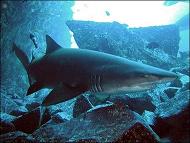
So, apparently some Australian scientists are attempting to create artificial shark uteruses — so that they can prevent fetal sharks from eating each other in the womb.
Yes, you read that correctly. Here’s the deal: The average female grey nurse shark begins her pregnancy with about 40 embryos in her two uteruses. But it takes a year for the baby sharks to gestate, and by the time they’re ready to be born, there are only two left — one in each uterus. Why? Because by four months they’ve developed a full set of teeth, and the strongest begin cannibalizing the weaker ones. Ay yi yi. I’d heard of wild dingos getting into deathmatches right after being born, but this takes the whole red-in-tooth-and-claw stuff up to the next level.
Anyway, the grey nurse shark population is apparently critically endangered, and since they’re the top predators in the oceanic food chain, the ecosystem could be unpredictably unbalanced if they all vanish. So the scientists are trying to develop an artificial shark uterus so they can capture a pregnant female, flush out the embryos, and raise them independently so they can all be born.
Of course, as Slate wondered, maybe this attempt to tinker with Mother Nature is doomed to failure. Maybe the embryo sharks need to feed on one another to survive long enough to be born; and maybe the pre-birth contest serves to winnow out sharks that wouldn’t prosper in the wild anyway. Scientists aren’t sure, as an AFP story notes:
No accepted explanation has been established for why the grey nurse sharks take sibling rivalry to such extreme lengths.
“It would seem logical that the intra-uterine cannibalism does confer some sort of evolutionary advantage, somewhat similar to the survival of the fittest, but it may be the luck of the draw because even the biggest could be attacked,” Otway said.
Well, that’s gotta be a conversation-stopper at cocktail parties. “So, what do you do for a living?” “Oh, I design artificial shark uteruses to prevent inter-uterine embryo cannibalism.”
(Thanks to Franco for this one!)
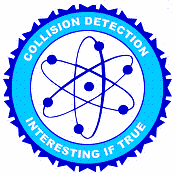
Heh. This is cute: An Official Seal Generator, so you can generate your own faux-institutional seal of approval. There’s mine above!
The logo text, in case you’re wondering, comes from an old saying in newsrooms: “Interesting if true.” It’s a pithy way of saying “wow, this news story tip would make for a superb scoop … if it actually turns out to be real.” It’s a distant relative of the much more ignoble (ignobler?) dictum of yellow journalism: “Too good to check.”
Anyway, I’ve always wanted to have a big rubber stamp saying INTERESTING IF TRUE that I could thwack down on intriguing story leads.
(Thanks to 43 Folders for this one!)

The humble manatee gets no respect. With its potato-like head, stubby flippers, and blimp-shaped body, it looks like something evolution left behind a long time ago. When a manatee recently drifted north and wound up swimming in the Hudson River next to Manahattan, the main reaction from city residents was man, that thing is ugly. Worse, its brain is almost entirely smooth on the outside; and since neurologists typically assume that a more-folded brain indicates higher intelligence, scientists have long assumed manatees are slow, dopey idiots: The cows of the briny deep.
Ah, but this foul libel is finally being lifted — because a new generation of scientists are finally getting interested in the unusually dense vibrissae, sensory whiskers, that cover a manatee’s body. (They use them to detect undersea plants, and they’re accurate up to 0.05 millimeters.) Plenty of animals have vibrissae, but not in such huge numbers, and usually only on their faces.
So when you peel back the hood on the manatee’s much-maligned brain, it turns out to be a torqued-up machine of deep neurological weirdness. Roger Leep, a neuroscientist at the University of Florida, explored sensory clusters in the brain that process information from the whiskers, and made a startling discovery. As the New York Times’s Science section reported this week:
Even more tantalizing is that, in the manatee, these clusters extend into a region of the brain believed to be centrally involved with sound perception.
“Either these things have nothing to do with the hair at all, or the more exciting possibility is that perhaps somatic sensation is so important that the specialized structure is overlapping with processing going on in auditory areas,” Dr. Reep said.
Manatee synesthesia!! I could not be more excited. It reminds me, in a mental random-linking way, of those experimental rigs that let you use your tongue to “see” visual information.
I'm Clive Thompson, the author of Smarter Than You Think: How Technology is Changing Our Minds for the Better (Penguin Press). You can order the book now at Amazon, Barnes and Noble, Powells, Indiebound, or through your local bookstore! I'm also a contributing writer for the New York Times Magazine and a columnist for Wired magazine. Email is here or ping me via the antiquated form of AOL IM (pomeranian99).

ECHO
Erik Weissengruber
Vespaboy
Terri Senft
Tom Igoe
El Rey Del Art
Morgan Noel
Maura Johnston
Cori Eckert
Heather Gold
Andrew Hearst
Chris Allbritton
Bret Dawson
Michele Tepper
Sharyn November
Gail Jaitin
Barnaby Marshall
Frankly, I'd Rather Not
The Shifted Librarian
Ryan Bigge
Nick Denton
Howard Sherman's Nuggets
Serial Deviant
Ellen McDermott
Jeff Liu
Marc Kelsey
Chris Shieh
Iron Monkey
Diversions
Rob Toole
Donut Rock City
Ross Judson
Idle Words
J-Walk Blog
The Antic Muse
Tribblescape
Little Things
Jeff Heer
Abstract Dynamics
Snark Market
Plastic Bag
Sensory Impact
Incoming Signals
MemeFirst
MemoryCard
Majikthise
Ludonauts
Boing Boing
Slashdot
Atrios
Smart Mobs
Plastic
Ludology.org
The Feature
Gizmodo
game girl
Mindjack
Techdirt Wireless News
Corante Gaming blog
Corante Social Software blog
ECHO
SciTech Daily
Arts and Letters Daily
Textually.org
BlogPulse
Robots.net
Alan Reiter's Wireless Data Weblog
Brad DeLong
Viral Marketing Blog
Gameblogs
Slashdot Games